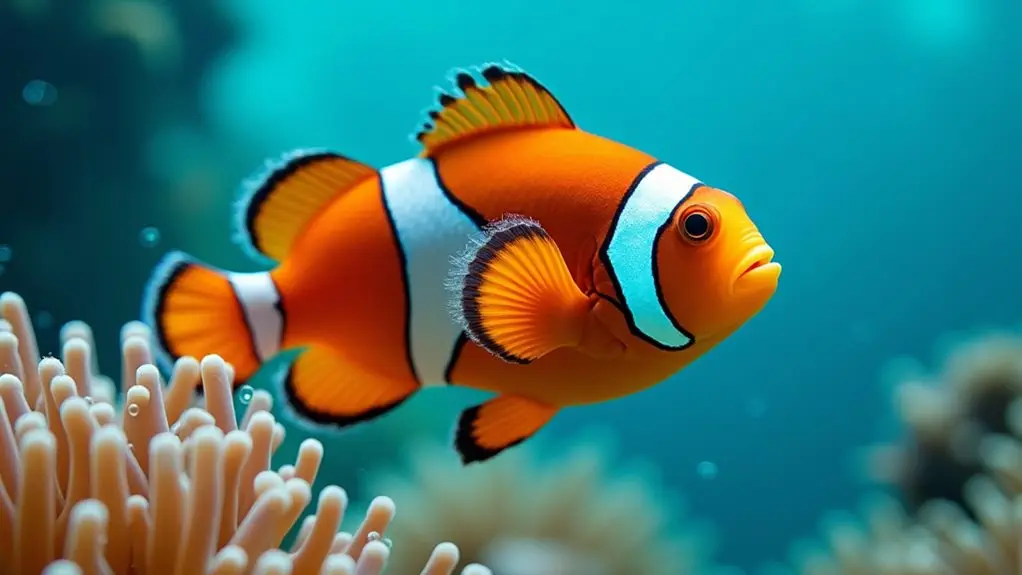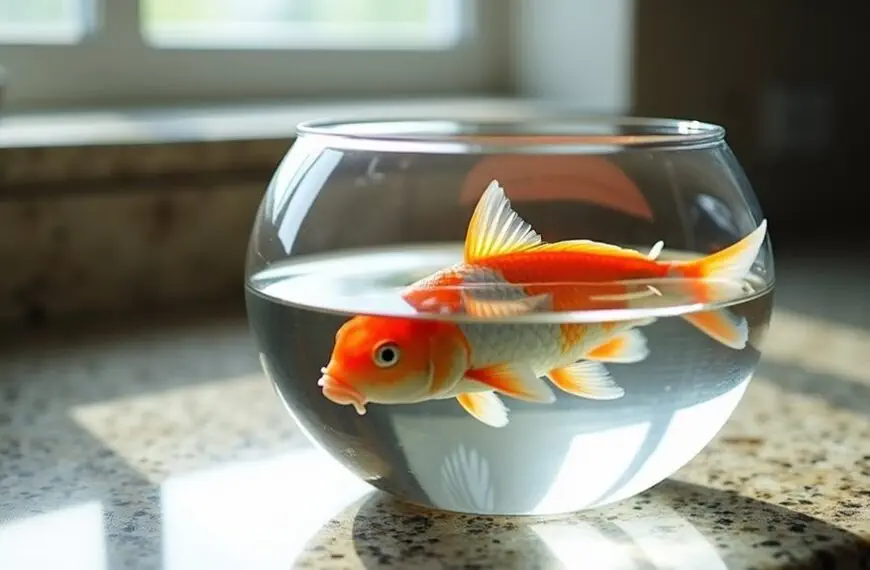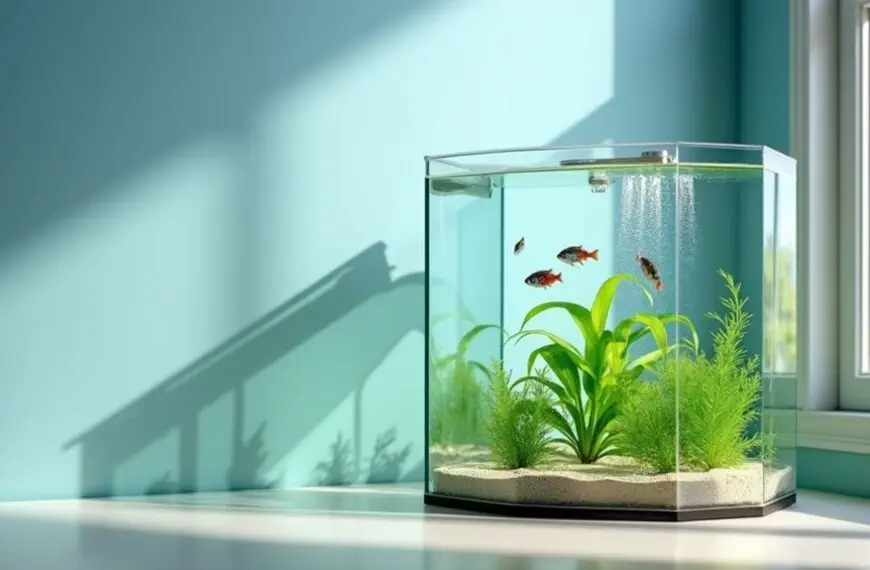You can spot a happy fish through several key signs. A content fish will swim actively and explore its tank with smooth, steady movements rather than darting erratically. They'll show off bright, vibrant colors and keep their fins spread proudly instead of clamped to their body. Watch for enthusiastic feeding behavior – happy fish get excited at mealtime and swim right up for their food. They'll also interact peacefully with tank mates, joining in social activities like schooling. Clear eyes, healthy scales, and regular breathing patterns are other positive indicators. These clues are just the surface of understanding your aquatic friend's well-being.
Contents
Signs of a Healthy Fish

While many fish owners struggle to interpret their pets' well-being, several clear physical indicators can help you determine if your fish is healthy. Your fish's scales condition is one of the first things you'll want to check – they should be smooth, evenly distributed, and showcase vibrant colors without any rough or discolored patches. Regular attention to water quality parameters such as pH and ammonia levels will also greatly contribute to your fish's overall health.
You'll also want to pay attention to eye clarity, as healthy fish have bright, alert eyes without any cloudiness or discharge. Regular water quality testing is essential for maintaining clear, healthy eyes and overall fish wellness. Quick consumption of meals during feeding times is another positive sign of good health.
Take a close look at your finned friend's overall appearance and behavior. Those fins should be intact and held proudly away from the body, not torn or clamped down.
If you notice your fish swimming actively around the tank, exploring its environment, and maintaining a normal body shape (unless it's carrying eggs), you've got a happy swimmer on your hands!
Watch how they interact with tank mates too – healthy fish are typically social butterflies, peacefully schooling with others and showing genuine curiosity about their surroundings. They shouldn't be hiding excessively or showing signs of aggression, and when it's feeding time, they should be front and center, ready for their meal.
Swimming Patterns and Movement
Your fish's swimming behavior acts as a window into their well-being. When they're happy, you'll notice a consistent swimming speed and smooth movement style that shows they're feeling right at home. Just like us on a good day, content fish will actively explore their environment, darting playfully between plants and decorations while maintaining a steady, purposeful pace. Vibrant colors and shine typically accompany these positive swimming patterns, indicating optimal health. A healthy fish will display erect fins as they swim, demonstrating their comfort in the environment. Maintaining proper water parameters is essential for fostering this sense of well-being.
Here are three key swimming patterns that indicate your finned friend is thriving:
- Graceful, fluid movements without any erratic darting or spinning
- Regular exploration of different tank levels, rather than hiding in one spot
- Playful interactions with tank mates, showing curiosity without aggression
If you notice your fish's movement style changing dramatically – like swimming sideways, floating listlessly, or hiding constantly – it's time to investigate.
These behaviors often signal that something's not quite right in their world. Keep an eye on their swimming speed too; a happy fish maintains a steady pace rather than frantically zooming around or barely moving at all.
Color Changes and Appearance
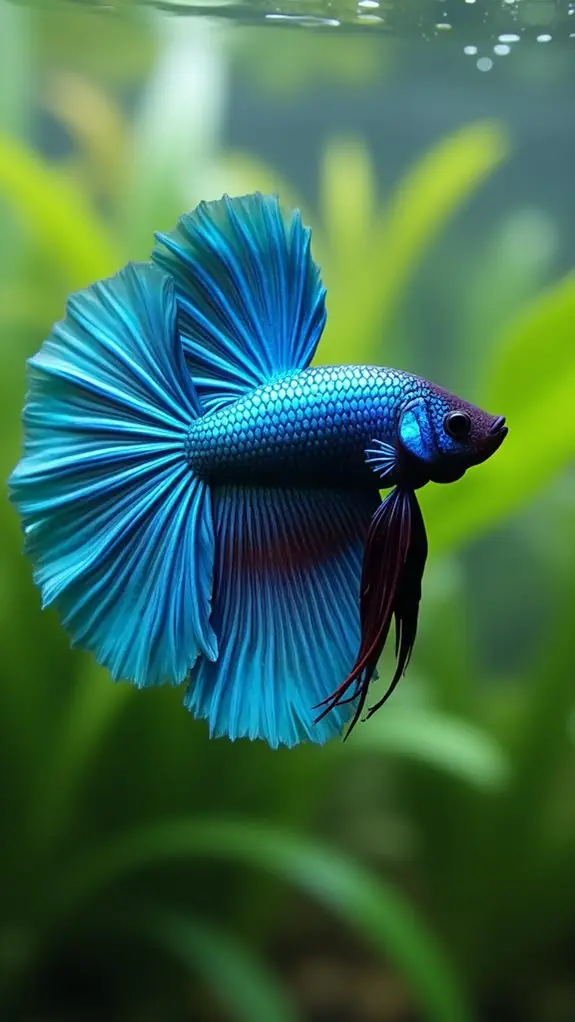
Beyond swimming patterns, a fish's color and appearance offer clear signals about their happiness and health. When your fish is thriving, you'll notice striking color vibrancy that makes them look like living jewels in your aquarium. Happy fish maintain their natural, species-specific colors, whether they're a vibrant betta or a shimmering guppy. Studies show that tank color can significantly affect a fish's stress levels and overall wellbeing. Moreover, maintaining optimal pH levels is crucial as it contributes to their vibrant appearance and overall health.
Keep an eye on your fish's physical appearance, too. A content fish will display smooth, intact fins that flow gracefully through the water, along with clear, bright eyes that sparkle with energy. Their scales should have a healthy sheen, free from any rough patches or unusual marks. These are all positive mood indicators that your aquatic friend is feeling great. Proper water filtration and chemistry will help maintain these vibrant appearances.
You'll also notice that happy fish use their colors to communicate. They might become more vivid during social interactions or courtship displays – it's like they're putting on their best outfit for a special occasion!
If you notice your fish's colors becoming dull or patchy, it's often a sign they're stressed or uncomfortable, and it's time to check their environment and care routine.
Feeding Time Behavior
During feeding time, one of the clearest indicators of a happy fish is its enthusiastic response to food. You'll notice your aquatic friends keenly swimming to the surface or their usual feeding spots, showing excitement for their upcoming meal. These behavioral cues tell you a lot about their overall well-being and contentment in their environment. Daily observation helps maintain awareness of normal feeding patterns. Maintaining stable water conditions is also vital for their happiness.
Studies show that hungrier fish position themselves at the front of fish groups during feeding times. Establishing consistent feeding routines helps you identify what's normal for your fish. When they're happy and healthy, you'll observe:
- Active swimming and exploration during mealtimes
- Quick consumption of food without hesitation
- Species-appropriate feeding patterns (like tetras feeding up top while catfish grab food from below)
If you notice your fish isn't following its usual feeding patterns, it might be trying to tell you something's wrong.
Watch out for signs like hiding during feeding time, leaving food uneaten, or swimming erratically. These changes could indicate stress or health issues that need attention.
Social Interactions With Tank Mates
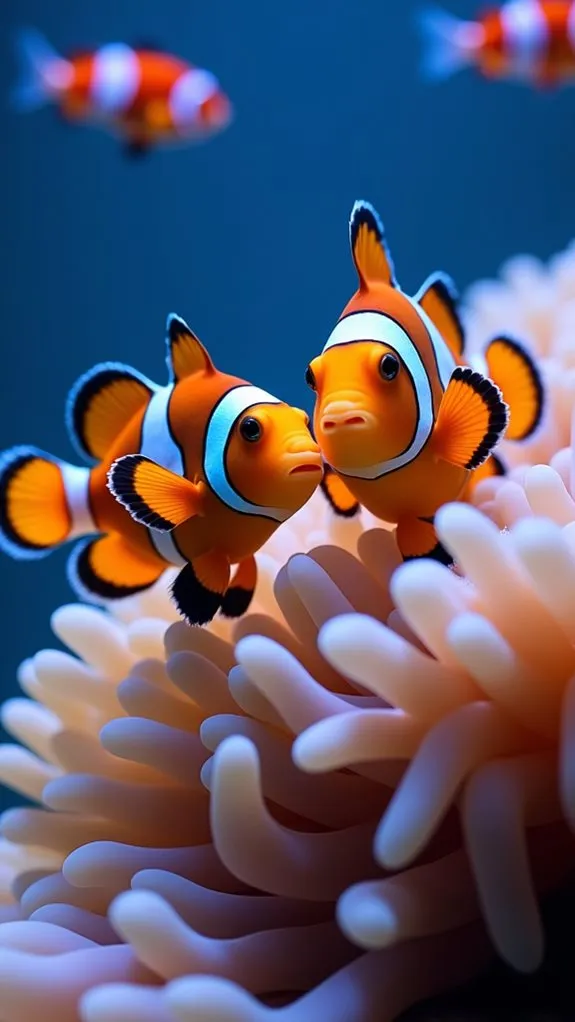
Just as mealtime behavior offers insights into a fish's happiness, social interactions between tank mates tell an equally important story. When your fish engage in natural schooling behavior and maintain a peaceful social hierarchy, you can be confident they're feeling secure and content. Fish communities have evolved over millions of years to develop complex social networks. Visual and chemical signals help fish establish natural hierarchies within the group, which is essential for their overall well-being.
You'll notice happy fish actively swimming together, almost like they're playing a friendly game of follow-the-leader. Additionally, these species thrive better in groups, allowing for social interactions that contribute positively to their happiness. Keep an eye out for positive signs like synchronized swimming and curious exploration of the tank environment. Happy fish will interact with their tank mates without showing aggression or constantly hiding. If you see your fish displaying vibrant colors and freely moving around the tank with their companions, that's a great indication they're thriving in their community.
However, if you notice any fin nipping, excessive hiding, or aggressive chasing, it's time to take action. These behaviors often signal stress or incompatibility between tank mates. You can help maintain harmony by providing plenty of hiding spots, ensuring appropriate tank size, and carefully selecting compatible species. Think of yourself as a peaceful neighborhood planner – your goal is to create an environment where everyone gets along swimmingly!
Tank Environment and Water Quality
Your fish's well-being starts with crystal-clear water and a carefully planned tank setup, just like you wouldn't want to live in a murky, cramped apartment.
You'll want to check that your tank's water sparkles like a mountain stream while maintaining proper filtration and regular water changes to keep your finned friends healthy and active.
Setting up safe spaces with natural decorations, proper lighting, and stable temperatures will help your fish feel right at home, letting them show off their true colors and personalities. Additionally, ensuring a stable water temperature is crucial for the comfort of your fish species.
Crystal Clear Water Matters
With crystal clear water beckoning from your aquarium, it's crucial to understand that appearances can be deceiving. While water clarity might look perfect, your fishy friends need more than just visually pristine conditions to thrive.
Regular maintenance practices, including water testing and filter checks, are necessary for keeping your aquatic pals happy and healthy.
Here's what you'll want to monitor to guarantee your fish are truly living their best lives:
- Test your water parameters weekly – ammonia and nitrite should be at zero, while pH stays stable.
- Perform regular water changes to maintain peak conditions.
- Keep your filter clean and running efficiently to remove harmful toxins.
You're not just maintaining an underwater display case – you're creating a thriving ecosystem! Maintaining optimal water quality parameters is vital for preventing stress and ensuring the longevity of your fish.
When you notice your fish swimming actively and displaying vibrant colors, you'll know your efforts are paying off.
Remember, even if your tank looks spotless, regular testing is your best friend. Think of it like a health check-up for your underwater community.
Safe Space Setup Essentials
Creating a safe aquarium environment consistently ranks among the most critical aspects of fish keeping. Just like you wouldn't want to live in a house with unstable foundations, your fish need a properly set-up home to thrive and show signs of happiness.
When it comes to tank placement, you'll want to position your aquarium on a sturdy stand away from direct sunlight and heat sources – trust me, your fish won't appreciate unexpected temperature swings!
Before adding water, you'll need to focus on gravel preparation, which involves thoroughly rinsing it to remove dust and debris. Once clean, spread it evenly to create a two-inch base that'll support healthy plant growth and provide a natural-looking habitat.
Don't forget to leave enough space between plants; they need room to stretch their leaves, just like we need space to stretch our legs!
Remember to treat tap water with a conditioner and establish beneficial bacteria before introducing your finned friends. It's like preparing a new house – you wouldn't move in before the utilities are working properly! Additionally, it's crucial to ensure the ideal pH is maintained between 6.5 and 8.5 for the health of nitrifying bacteria.
Regular maintenance and water testing will guarantee your fish remain content in their well-planned paradise.
Breathing and Gill Movement
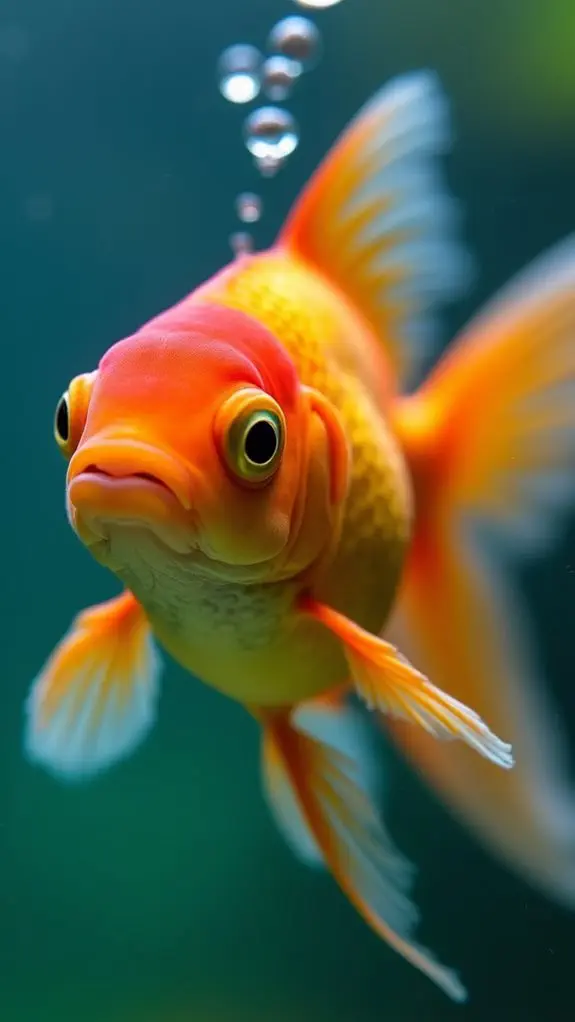
When you're checking on your fish's happiness, you'll want to keep a close eye on their breathing patterns and gill movements.
Your finned friend should show steady, rhythmic breathing without gasping at the surface or showing signs of distress.
Healthy fish typically display consistent gill movements (about 20-80 per minute), and they won't need to hang out at the top of the tank struggling for air. Additionally, maintaining optimal water quality parameters is crucial for their overall well-being.
Steady Breathing Patterns
One of the clearest signs of a happy fish is its steady, natural breathing pattern. When your finned friend maintains a consistent breathing rhythm, it's displaying a state of aquatic tranquility that suggests all is well in their underwater world.
You'll notice their gills moving at regular intervals, without any gasping or rapid movements that might indicate distress.
To help you recognize healthy breathing patterns in your fish, here are three key things to watch for:
- Regular opercular movements that aren't too fast or too slow
- Breathing that stays consistent, without sudden changes in pace
- No gasping at the surface unless it's a labyrinth fish (like bettas)
Your fish's breathing pattern can tell you a lot about their well-being and water quality. It's important to remember that factors such as regular water quality checks can prevent toxic buildup that may lead to distress in your fish.
If you notice they're breathing more rapidly than usual or gasping at the surface, it might mean there's too much CO2 or not enough oxygen in the water.
Think of it like how we breathe calmly when we're relaxed but might pant when we're stressed – fish aren't so different!
Healthy Gill Movement
Beyond breathing patterns, healthy gill movement provides deeper insight into your fish's well-being. When you're watching your aquatic friend, you'll notice that normal gill function involves smooth, steady movements without any erratic behavior. Think of it like calm, relaxed breathing – that's what you want to see in your fish.
Your fish's gills are actually quite remarkable, performing multiple jobs beyond just breathing. They handle important tasks like regulating body fluids, removing waste, and even producing hormones. If you notice your fish breathing rapidly or hanging around the filter output, they might be struggling with gill diseases or poor water quality. It's like when we feel short of breath – something's not quite right.
Keep an eye out for warning signs that could indicate unhealthy gill movement. If your fish seems tired, shows faded colors, or clamps its fins, it's trying to tell you something's wrong.
The good news is that many gill problems are preventable by maintaining excellent water quality and watching for early signs of stress. Your fish will thank you with vibrant colors and peaceful swimming patterns!
Frequently Asked Questions
Do Fish Sleep, and How Can You Tell if They're Sleeping?
Yes, fish have unique sleep patterns where they rest while remaining partially alert. You'll notice their resting behaviors when they float motionless, hover near the bottom, or hide in specific spots with slower responses.
Can Fish Recognize Their Owners and Show Affection?
Yes, many fish can recognize their owners through visual and behavioral cues. You'll notice signs of owner recognition when your fish swims excitedly toward you, follows your movements, or shows distinct behavior during feeding times.
Why Do Some Fish Jump Out of Their Tanks?
Your fish's jumping behavior can be triggered by poor tank conditions, stress from aggressive tankmates, or natural instincts. Some species naturally jump, while others might leap to escape unfavorable water quality or threats.
Do Fish Get Bored, and How Can You Entertain Them?
Yes, fish can get bored. You can entertain them with tank enrichment like live plants, caves, and fish toys. Try adding floating decorations, changing tank layouts, and using interactive feeding methods to keep them stimulated.
How Long Can Fish Remember Things and Learn New Behaviors?
You'll find that fish have impressive memory capacity, retaining information from days to years. They can learn and adapt behaviors through training, with some species remembering feeding routines and social interactions for several months.
Final Thoughts
You'll know your fish is happy when it displays several key behaviors and signs of good health. Keep an eye on its vibrant colors, active swimming patterns, and enthusiastic appetite at feeding time. Remember, a content fish will also interact positively with tank mates and show steady gill movements in clean, well-maintained water. By monitoring these telltale signs, you're ensuring your finned friend is thriving in its aquatic home.

